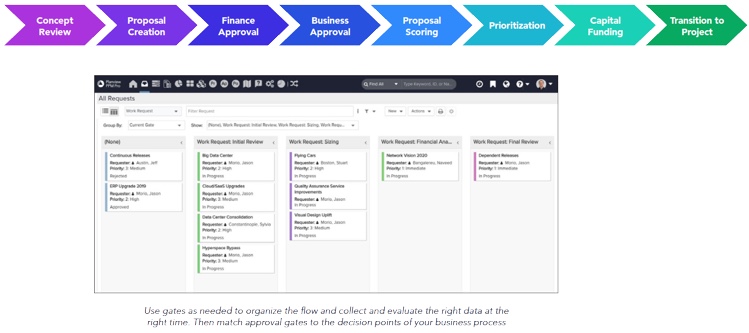
An indiscriminate approach to work intake and requests is a competitive disadvantage in today’s rapidly shifting business environments. Consider an IT department without an established IT demand management process: They simply say yes to everything regardless of relevance or value. Taking control of this beast requires the ability to see new project demand and route requests through a centralized intake process.
Whether you are establishing a demand management process or want to improve your approach, this blog presents some functionality to explore using Planview PPM ProTM as an example.
First, here’s a look at the challenges of not having a mature IT demand management (or other) process.
IT Demand Management Challenges
- Competitive Setbacks: If people cannot easily request new projects or check the status of work, your organization may lose out on the next great idea or initiative.
- Over Promise and Under Deliver: An IT department or PMO that greenlights every project can clog their portfolio with lower value initiatives, overload and waste resources, and fail to align every request to company strategy. Resource conflicts, project delays, and cost overruns can cause low morale and other negative impacts.
- Limited Strategic Delivery: With no objective means of collecting and evaluating requests, PMOs are subject to what Michael Gentle calls “decibel management.” He or she who yells the loudest gets served first, even without a compelling business case. Often work that should never have been done in the first place progresses forward.
- Skewed ROI: When requests cannot be tied to strategy, IT departments and others define return on investments as simply completing projects on time and on budget.
- Wasted Time and Effort: Without a standardized or consistent workflow process in place, people may not understand their responsibilities – or those of others – for evaluating requested work. This could delay other approvers or cause multiple people to evaluate the same work unnecessarily. In addition, determining if the work is worthwhile could mean a lot of ad-hoc, needless back and forth between employees.
- Circumvention: People may become frustrated with a process that is not streamlined or doesn’t have a standardized workflow, causing progress delays. As a result, they may go around the PMO to get their work done. This is bad news for the organization trying to establish process and consistency.
- Poor Visibility: Without a way to track and highlight how much work is requested and processed, stakeholders and executives have no idea of the impact, positive or negative, to the organization. It is also difficult to adjust resources and predict imminent and future work resource needs without knowing what is already in the funnel.

IT Demand Management Process
A consistent, transparent, and easily understood demand management process ensures the organization approves and prioritizes work that supports strategic initiatives. Managing work intake or demand starts by creating a single entry point for work requests. Next, PMOs can automate the process of evaluating and approving requests.
This includes gathering the supporting data and evaluations in a logical way to streamline the process. Gates are used as needed to organize the flow as well as collect and evaluate the right data at the right time. Then you can match approval gates to the decision points of your business process. A strategic work intake process could look something like this:

The process should enable you to kill unnecessary work requests as soon as possible, defer or place low-value work on hold, and advance high-value work quickly.
Planview PPM Pro Facilitates IT Demand Management
PPM Pro’s requests feature shows what’s possible in streamlining IT demand management. If you are not a customer, here’s some PPM Pro parlance: The outcome of a request is the creation of or updating one or more entities for performing the requested work, which can be PPM Pro projects, project logs, or tasks. After it is created or updated, an entity can then be managed by PPM Pro. You can also use a request as its own entity, such as a work ticket. A request can capture and enable work in its own right, without requiring a project, task, or project log.
We consider the following features leading-edge upgrades for our customers:
Multiple categories: This gives PPM Pro users the power to create various request workflows. With this flexibility, you can model your intake demand business processes and diverse organization work needs.
Each request category can have unique Details forms, including the same or different user-defined fields. Details fields can be hidden, shown as editable, or shown as view only at each gate. Each category can also have different notes, attachments, scoring, and other sections appear at – you guessed it – different gates. These workflow design capabilities enable you to streamline the intake data collection and approval process.
Multiple approver logic: PPM Pro users can configure multiple approvers to ensure the right people provide information or approve a request. The Multiple Approvers logic is flexible, enabling you to configure the relevant number and identity of approvers based on your organization’s needs and the contents of the request.
The gate’s Multiple Approvers logic identifies which users have implicit permission to approve the request at that gate (user, group members, unit members). When all conditions for Gate Approvers listed in the Multiple Approvers logic are satisfied, a request is approved to move to the next gate, or becomes fully approved at the last gate.
Gate skipping logic: Advanced gate logic streamlines the IT demand management workflow to move requests through the process as swiftly as appropriate. You can skip gates based on request field properties, such as who the requester is, the budget amount, or a date. For example, you could skip approval at some gates if:
- a member of the IT PMO submitted the request, or
- a request is for internal consumption as opposed to external, or
- the estimated size of work is small as opposed to large.
None to many requests to associated entities: A request category does not have to have associated entities or resulting work. If it does, you can configure the request category to include project, task, and project log associations.
This flexibility helps your requesters, who do not need to know up front what entity might result from the request. It also enables you to split up the requested work as appropriate, for example, to associate the requested work to a new task and a new project log on an existing project, to two new projects, to three different project logs, and so on.
A Kanban card view: PPM Pro now includes a card view, which is a “kanban” board that allows users to easily track the progress of cards (requests) from lane to lane, and generally provides a visual workflow that some users prefer. The requests are represented as cards that the user can group kanban-style by Gate Status, Current Gate (when view is filtered on a single category), Category, Business Objective, and other discrete fields.
Reminder notifications at gates: When a request has been sitting at a gate for a period of time, a reminder notification (aka “nag-o-gram”) can be configured and sent only to relevant gate approvers who have not yet approved. This can recur daily, weekly, or monthly as configured, including a link to the request. This helps prevent the request from getting hung up at a gate unnecessarily.

IT Demand Management Is a Starting Point
Take control of the work being done in your organization, ensuring alignment to your organizational goals and better return on the investments you are making. By developing a strategic work intake process and implementing it across your business, you can identify the highest value work.
Combining demand management with prioritization, resource planning, and portfolio management, you can continually deliver against strategy. For example, no longer beholden to guestimates, opinions, or vanity projects, you can work with stakeholders to prioritize projects that support business goals. With a holistic view of demand and resource capacity, the PMO can counsel business leaders on what can realistically be achieved, and which additional resources are needed. Planview PPM Pro has many other valuable capabilities. To learn more, visit https://www.planview.com/products-solutions/products/ppm-pro/.




